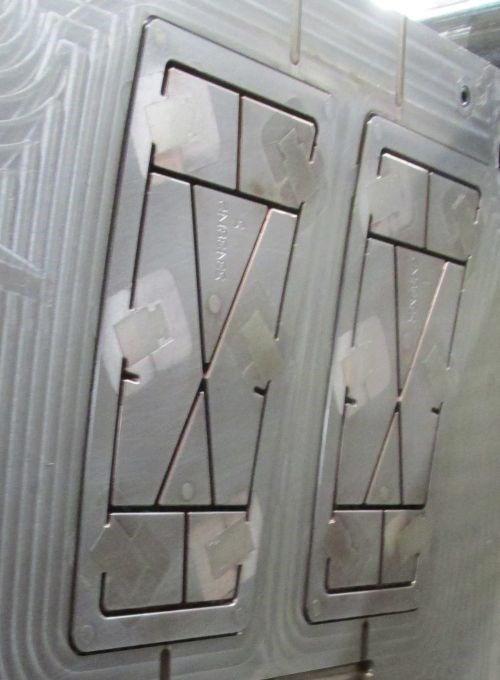Round Tool, Square Corner
This moldmaker didn’t need wire EDM to cut pockets with 90-degree corners into a mold’s cavity plate. Along with a bit of ingenuity, a round end mill proved perfectly sufficient.

Accommodating vertical lifters in this cavity plate required square-cornered pockets. To avoid the need for wire EDM, the shop found an innovative solution: machining an outer, oversized pocket with rounded corners into the plate, then machining two U-shaped pieces of steel to form an inner pocket for a snug fit with the lifters.
Round end mills aren’t ideal for producing square corners, but they can do the job. They just have to be applied a bit differently. “You can cut a 90-degree angle as long as you’re using the tip of the cutter and not the edge of the cutter,” explains Tony Machado, president of Mid Missouri Tool and Die.
In other words, the end mill can’t change direction during the cut. Given the tool’s rounded edge, making a turn would leave a slight radius in the material. Straight-line passes, however, leave a channel with straight walls and floors. Make two intersecting, perpendicular passes, and there’s your corner.
As described in this case study, Mid Missouri Tool and Die recently applied this general principle to machine square pockets required to accommodate vertical lifters in a mold’s cavity plate. Of course, this wasn’t as simple as machining perpendicular channels—that would be impossible without marring the rest of the cavity plate. Rather, it involved machining what are essentially pockets within pockets.
Each outer pocket, machined directly in the cavity plate, has rounded edges and is slightly oversized to leave 0.375 inch of space on all four sides of the lifter. That space is filled by two U-shaped pieces of steel inserted end-to-end to form the square-cornered inner pocket. Each piece required two VMC setups. First, the corner radii on one end were machined to match the rounded pocket in the tool. Then, a pass across the entire width of the part created a flat, squared surface on the other end. For the second setup, the workpiece was mounted flat-side-up for straight-line passes that removed a chunk of material from the center to form the square-cornered interior of the U shape.
Of course, the shop might not have had a chance to solve this problem if it hadn’t won the job in the first place—and for that, Machado gives much of the credit to the design of the lifters themselves (Cumsa's DH series). Read the article for more about that. Nonetheless, this application demonstrates that even as technology continues to advance and make things easier, success in this industry still requires problem-solving and ingenuity.















